Bax transmembrane domain interacts with prosurvival Bcl-2 proteins in biological membranes
- PMID: 28028215
- PMCID: PMC5240701
- DOI: 10.1073/pnas.1612322114
Bax transmembrane domain interacts with prosurvival Bcl-2 proteins in biological membranes
Erratum in
-
Correction to Supporting Information for Andreu-Fernández et al., Bax transmembrane domain interacts with prosurvival Bcl-2 proteins in biological membranes.Proc Natl Acad Sci U S A. 2017 Feb 21;114(8):E1574. doi: 10.1073/pnas.1701233114. Epub 2017 Feb 13. Proc Natl Acad Sci U S A. 2017. PMID: 28193890 Free PMC article. No abstract available.
Abstract
The Bcl-2 (B-cell lymphoma 2) protein Bax (Bcl-2 associated X, apoptosis regulator) can commit cells to apoptosis via outer mitochondrial membrane permeabilization. Bax activity is controlled in healthy cells by prosurvival Bcl-2 proteins. C-terminal Bax transmembrane domain interactions were implicated recently in Bax pore formation. Here, we show that the isolated transmembrane domains of Bax, Bcl-xL (B-cell lymphoma-extra large), and Bcl-2 can mediate interactions between Bax and prosurvival proteins inside the membrane in the absence of apoptotic stimuli. Bcl-2 protein transmembrane domains specifically homooligomerize and heterooligomerize in bacterial and mitochondrial membranes. Their interactions participate in the regulation of Bcl-2 proteins, thus modulating apoptotic activity. Our results suggest that interactions between the transmembrane domains of Bax and antiapoptotic Bcl-2 proteins represent a previously unappreciated level of apoptosis regulation.
Keywords: Bcl-2; apoptosis; mitochondria; oligomerization; transmembrane.
Conflict of interest statement
The authors declare no conflict of interest.
Figures




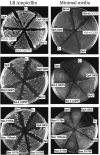
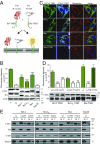
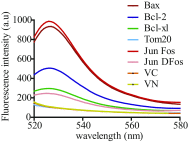
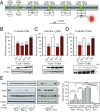




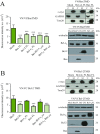


Similar articles
-
CHCHD2 inhibits apoptosis by interacting with Bcl-x L to regulate Bax activation.Cell Death Differ. 2015 Jun;22(6):1035-46. doi: 10.1038/cdd.2014.194. Epub 2014 Dec 5. Cell Death Differ. 2015. PMID: 25476776 Free PMC article.
-
Contribution of BH3-domain and Transmembrane-domain to the Activity and Interaction of the Pore-forming Bcl-2 Proteins Bok, Bak, and Bax.Sci Rep. 2018 Aug 20;8(1):12434. doi: 10.1038/s41598-018-30603-6. Sci Rep. 2018. PMID: 30127460 Free PMC article.
-
Distinct lipid effects on tBid and Bim activation of membrane permeabilization by pro-apoptotic Bax.Biochem J. 2015 May 1;467(3):495-505. doi: 10.1042/BJ20141291. Biochem J. 2015. PMID: 25714678
-
Discoveries and controversies in BCL-2 protein-mediated apoptosis.FEBS J. 2016 Jul;283(14):2690-700. doi: 10.1111/febs.13527. Epub 2015 Oct 27. FEBS J. 2016. PMID: 26411300 Review.
-
A brewing understanding of the regulation of Bax function by Bcl-xL and Bcl-2.Mech Ageing Dev. 2017 Jan;161(Pt B):201-210. doi: 10.1016/j.mad.2016.04.007. Epub 2016 Apr 23. Mech Ageing Dev. 2017. PMID: 27112371 Review.
Cited by
-
Virus-Mediated Inhibition of Apoptosis in the Context of EBV-Associated Diseases: Molecular Mechanisms and Therapeutic Perspectives.Int J Mol Sci. 2022 Jun 30;23(13):7265. doi: 10.3390/ijms23137265. Int J Mol Sci. 2022. PMID: 35806271 Free PMC article. Review.
-
Substance P prevents doxorubicin‑induced cardiomyocyte injury by regulating apoptosis and autophagy: In vitro and in vivo evidence.Mol Med Rep. 2022 Feb;25(2):50. doi: 10.3892/mmr.2021.12566. Epub 2021 Dec 16. Mol Med Rep. 2022. PMID: 34913064 Free PMC article.
-
MOMP, cell suicide as a BCL-2 family business.Cell Death Differ. 2018 Jan;25(1):46-55. doi: 10.1038/cdd.2017.179. Epub 2017 Oct 20. Cell Death Differ. 2018. PMID: 29053143 Free PMC article. Review.
-
Phenotyping of cancer-associated somatic mutations in the BCL2 transmembrane domain.Oncogenesis. 2024 Apr 26;13(1):14. doi: 10.1038/s41389-024-00516-3. Oncogenesis. 2024. PMID: 38670940 Free PMC article.
-
Phytochemical Analysis and In Vivo Anticancer Effect of Becium grandiflorum: Isolation and Characterization of a Promising Cytotoxic Diterpene.Nutrients. 2025 Mar 27;17(7):1164. doi: 10.3390/nu17071164. Nutrients. 2025. PMID: 40218923 Free PMC article.
References
-
- Youle RJ, Strasser A. The BCL-2 protein family: Opposing activities that mediate cell death. Nat Rev Mol Cell Biol. 2008;9(1):47–59. - PubMed
-
- Kim H, et al. Hierarchical regulation of mitochondrion-dependent apoptosis by BCL-2 subfamilies. Nat Cell Biol. 2006;8(12):1348–1358. - PubMed
-
- Kuwana T, et al. BH3 domains of BH3-only proteins differentially regulate Bax-mediated mitochondrial membrane permeabilization both directly and indirectly. Mol Cell. 2005;17(4):525–535. - PubMed
Publication types
MeSH terms
Substances
LinkOut - more resources
Full Text Sources
Other Literature Sources
Research Materials

